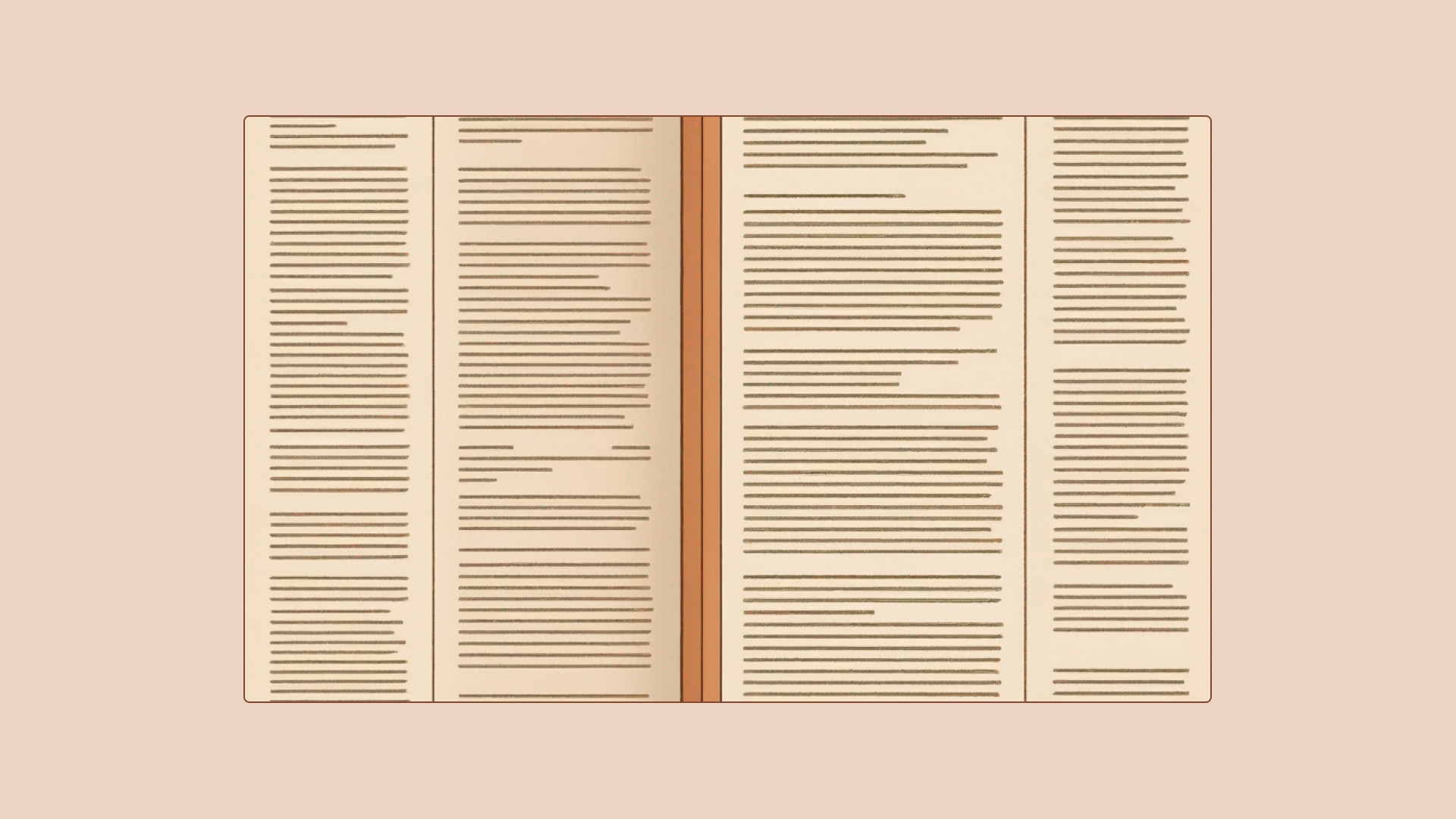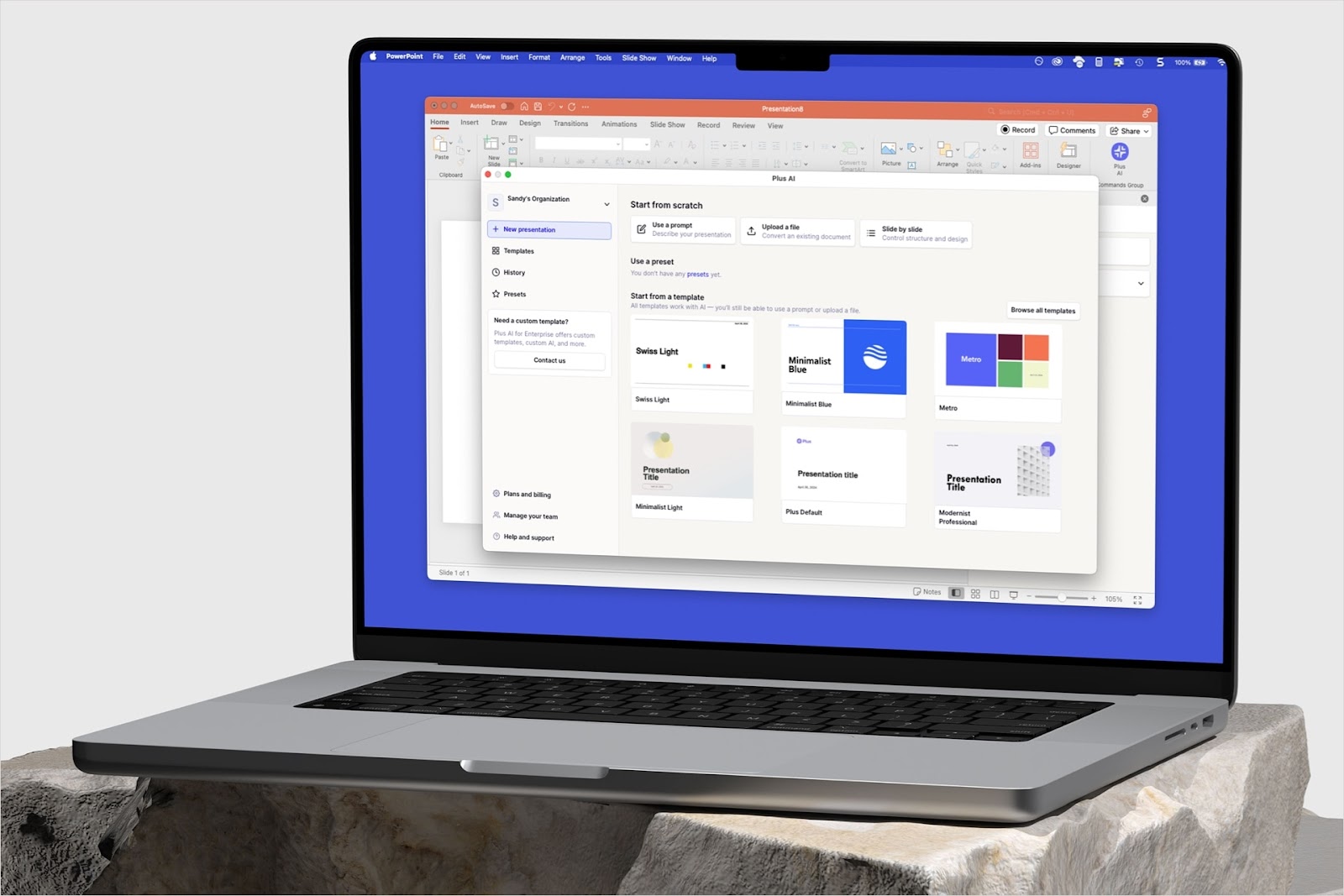When you’re planning out a presentation in Microsoft PowerPoint, one item to consider is the slide size. If you’re presenting the slideshow on your own screen, this is a bit simpler. But if not, you’ll need to consider where your audience will be viewing it such as on a mobile device or computer monitor.
We’ll guide you through the available sizes and dimensions for PowerPoint slides, how to adjust the size to fit your needs, and how an AI presentation maker like Plus AI can make quick work of building and editing presentations.
{toc}
Available PowerPoint sizes and dimensions
When you create a new presentation in PowerPoint, the slide size is set by default as Widescreen with a 16:9 aspect ratio. But you may want to make your slideshow fit a mobile screen, overhead projector, or older monitor. You can choose the size from a variety of preset options or use your own dimensions.
Standard (4:3): This preset gives you the original size and dimensions used by earlier Microsoft PowerPoint and Google Slides versions. Because it was intended for square monitors, it doesn’t work well on widescreen displays, but is still available if you need it.
Common 4:3 aspect ratio dimensions include 1024 by 768 and 1280 by 960 pixels.

Widescreen (16:9): This preset is the default size for new blank PowerPoint slideshows. It fits modern computer displays and TV screens making it the most widely-used slide size for presentations.
Common 16:9 aspect ratio dimensions include 1280 by 720 and 1920 by 1080 pixels.

Custom Slide Size: For additional presets such as letter size, 35mm slides, or your own exact dimensions, you can pick the Custom Slide Size option. Then, use the drop-down list to select a preset or choose Custom and enter the slide height and width.

How to change slide size in PowerPoint
When you’re ready to change the slide size for your presentation, you can do so in just a few steps. Keep in mind that you cannot use different sizes for individual slides or sections in the same presentation. Once you pick the size, it applies to all slides.
- With your slideshow open in PowerPoint, go to the Design tab.
- Select the Slide Size menu in the ribbon and choose the Standard or Widescreen preset or pick Custom Slide Size to use a different preset or enter the dimensions manually.

- You should see a prompt asking how you’d like to adjust your content. You can either maximize the slide content or scale it to fit. Pick Maximize or Ensure Fit per your preference.

You’ll then see your presentation update with the new slide size.
If you don’t like the new slide size, you can reverse the change. If you don’t make any other edits after changing the size, click Undo in the Quick Access Toolbar. Otherwise, follow the same steps above to pick the previous size.
Tips for after changing your PowerPoint slide size
When you change the size in PowerPoint after you have elements placed on your slides, you may need to make adjustments. This is especially true if you choose a vertical layout rather than a horizontal one. Things like text may need to be resized or images might need to be repositioned.
After you choose the new size, review each slide for these considerations:
- Text size: You might need to make the text larger or smaller for readability.
- Image and object placement: You may have to shift positions for images, videos, shapes, or other objects.
- Animations and transitions: You might need to reorder animations or edit transitions.
- Formatting: You may have to reformat tables, diagrams, or charts to better fit the new slide size.
- Whitespace: You might notice more or less empty space at the top or bottom of the slides that needs addressing.

Remember, you can make a copy of your presentation before you change the slide size or begin adjusting the slide elements. This allows you to experiment on a copy without losing your original slideshow setup.
To create a duplicate, go to File > Save a Copy. Edit the name to reflect the copy, optionally choose a new location, and click Save.
Create stunning presentations with Plus AI
If you’re struggling for the best design for your PowerPoint slideshow, especially with a unique slide size, you do have options such as AI presentation makers.
One tool to consider is ChatGPT for creating a PowerPoint presentation; however, it does have limitations. For example, you cannot create a PPT or PPTX file with this option. So, while you may get help composing informative content, it cannot “build” your presentation like with other tools.
A terrific presentation maker is Plus AI for Google Slides and Docs. With it, you can create a presentation using Slides and then download it to PowerPoint for a slideshow that’s ready to go.

Additionally, you can edit existing slideshows with the Plus AI add-on for Google Slides to enhance the appearance as well as improve the content.
Apply an attractive template, change the slide layout, or create a custom theme that you can reuse for consistent presentations. Additionally, you can ask Plus AI to add more content details, shorten specific text, or even translate it to another language.

Head to the Plus AI website for more on the complete feature set, to view video demos, see the template gallery, and start your free trial!
Conclusion
If your audience will be viewing your PowerPoint presentation on an unconventional display, you can make sure that it fits the screen by changing the slide size and dimensions. While it’s ideal to make the slide size decision from the start, it’s not always possible. So be sure to keep Plus AI in mind for editing your slideshows.
FAQs
How do you change the size of a PowerPoint slide without distortion?
You can avoid distorting your elements when you choose a new slide size with a simple setting. When you select the new size and the pop-up window displays, choose Ensure Fit to scale your slide elements without skewing them.
What are the best dimensions for a PowerPoint poster?
Using PowerPoint to create a poster gives you flexibility along with great features for the design, images, and text. Typical poster sizes range from 24 by 36 inches to 36 by 48 inches. Use the Custom Slide Size option in the Slide Size menu to set your poster size.
Why is PPT size too large?
If you’re trying to send or share your PowerPoint slideshow, you may run into trouble if the file size is too large. There can be a few reasons for the hefty presentation file size, so take a look at how to compress a PowerPoint slideshow for ways to decrease it.








